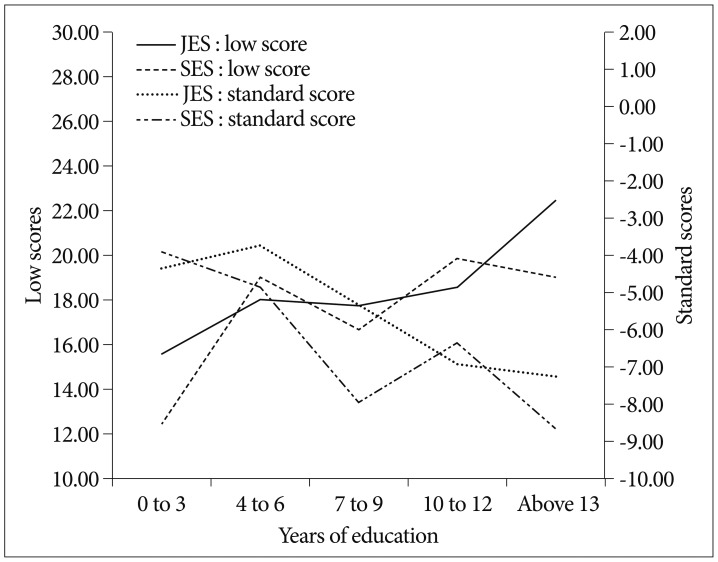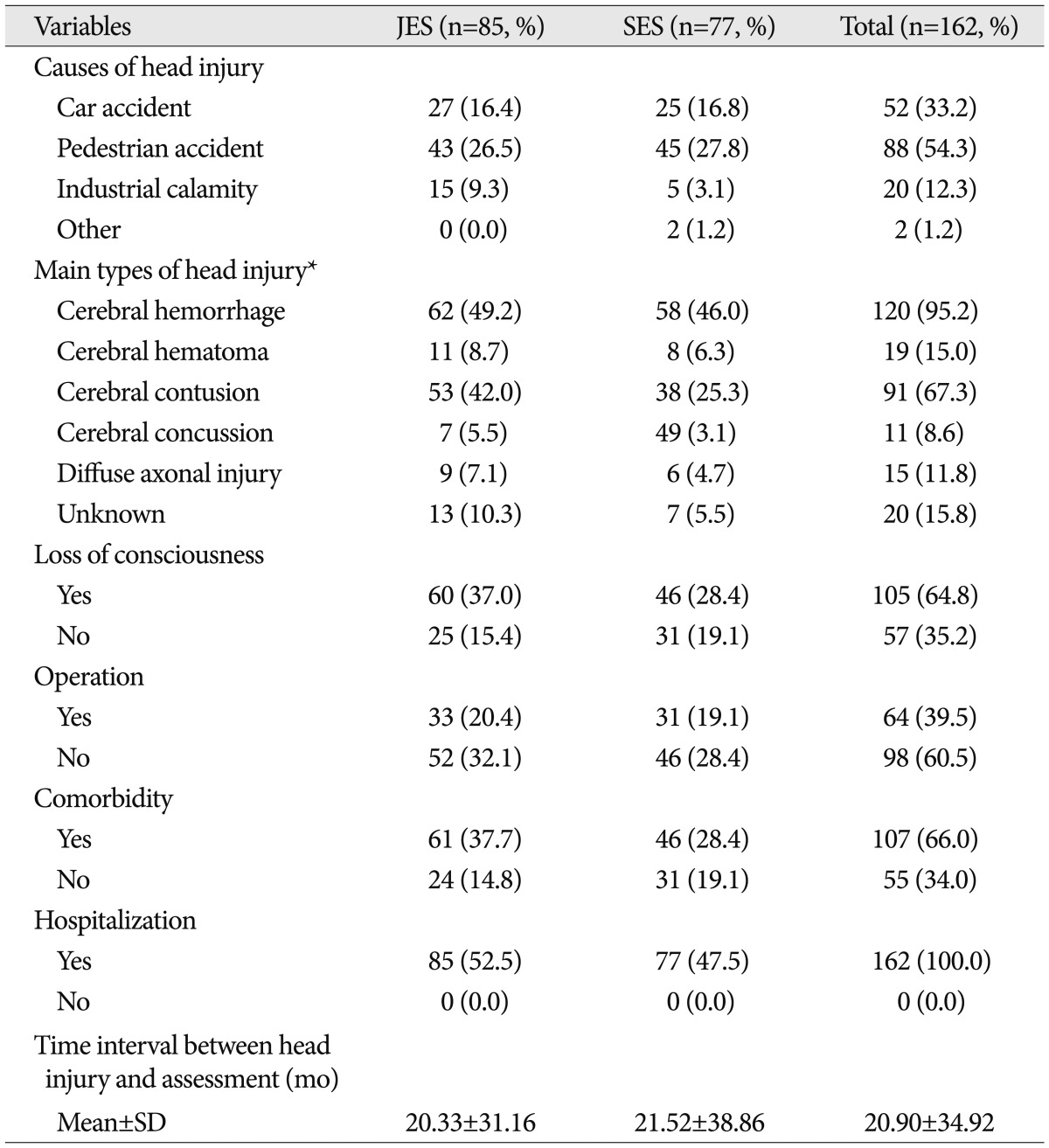1. Albert M, Duffy FH, Naeser M. Nonlinear changes in cognition with age and their neuropsychologic correlates. Can J Psychol. 1987; 41:141–157. PMID:
3502893.
2. Carroll LJ, Cassidy JD, Peloso PM, Borg J, von Holst H, Holm L, et al. Prognosis for mild traumatic brain injury : results of the WHO Collaborating Centre Task Force on Mild Traumatic Brain Injury. J Rehabil Med. 2004; (43 Suppl):84–105. PMID:
15083873.
3. Chesnust RM, Ghajar J, Maas AIR, Marion DW, Servadei R, Teasdale GM, et al. Early indicators of prognosis in severe traumatic brain injury. Brain Trauma Foundation, American Association of Neurological Surgeons. Management and Prognosis of Severe Traumatic Brain Injury. New York: Brain Trauma Foundaion;2000. p. 1–116.
4. Choi SH, Na DL, Lee BH, Hahm DS, Jeong JH, Yoon SJ, et al. Estimating the validity of the Korean version of expanded clinical dementia rating (CDR) scale. J Korean Neurol Assoc. 2001; 19:585–591.
5. Choi SW, Koh HS, Yeom JY, Kim SH, Song SH, Kim Y. Clinical analysis of the risk factors and prognostic factors of delayed deterioration following mild head injury. J Korean Neurosurg Soc. 1999; 28:1316–1323.
6. Depreitere B, Meyfroidt G, Roosen G, Ceuppens J, Grandas FG. Traumatic brain injury in the elderly : a significant phenomenon. Acta Neurochir Suppl. 2012; 114:289–294. PMID:
22327710.
7. Farace E, Alves WM. Do women fare worse? A metaanalysis of gender differences in outcome after traumatic brain injury. Neurosurg Focus. 2000; 8:e6. PMID:
16924776.

8. Fillenbaum GG, Peterson B, Morris JC. Estimating the validity of the clinical Dementia Rating Scale : the CERAD experience. Consortium to Establish a Registry for Alzheimer's Disease. Aging (Milano). 1996; 8:379–385. PMID:
9061124.

9. Hyde JS, Linn MC. Gender differences in verbal ability : a meta-analysis. Psychol Bull. 1988; 104:53–69.
10. Jeon IC, Kim OL, Kim MS, Kim SH, Chang CH, Bai DS. The effect of premorbid demographic factors on the recovery of neurocognitive function in traumatic brain injury patients. J Korean Neurosurg Soc. 2008; 44:295–302. PMID:
19119465.

11. Jeung YH. The Life Expectancy and Health-Adjusted Life Expectancy of Koreans. Health Welf Policy Forum. 2012; 193:5–18.
12. Kang YU, Na DL. Seoul neuropsychological screening battery. Incheon: Human Brain Research & Consulting Co;2003.
13. Kim E. Elderly. In : Silver JM, McAllister TW, Yudofsky SC, editors. Textbook of Traumatic Brain Injury. Arlington: American Psychiatric Publishing, Inc.;2005. p. 495–508.
14. Lezak MD, Howieson DB, Bigler ED, Tranel D. Neuropsychological Assessment. ed 5. New York: Oxford University Press;2012. p. 354–361.
15. Morris JC. The Clinical Dementia Rating (CDR) : current version and scoring rules. Neurology. 1993; 43:2412–2414. PMID:
8232972.
16. MRC CRASH Trial Collaborators. Perel P, Arango M, Clayton T, Edwards P, Komolafe E, et al. Predicting outcome after traumatic brain injury : practical prognostic models based on large cohort of international patients. BMJ. 2008; 336:425–429. PMID:
18270239.

17. Murray GD, Teasdale GM, Braakman R, Cohadon F, Dearden M, Iannotti F, et al. The European Brain Injury Consortium survey of head injuries. Acta Neurochir (Wien). 1999; 141:223–236. PMID:
10214478.

18. O'Neill S, Brady RR, Kerssens JJ, Parks RW. Mortality associated with traumatic injuries in the elderly : a population based study. Arch Gerontol Geriatr. 2012; 54:e426–e430. PMID:
22322093.
19. Park YS, Kim HJ, Whang K, Pyen JS, Hu C, Hong SK. Clinical characteristics and prognosis of mild head injury in the elderly. J Korean Neurosurg Soc. 2002; 31:564–568.
20. Shin TH, Gong CB, Kim MS, Kim JS, Bai DS, Kim OL. Development of a cognitive level explanation model in brain injury : comparisons between disability and non-disability evaluation groups. J Korean Neurosurg Soc. 2010; 48:506–517. PMID:
21430977.

21. Statistics Korea. Press materials : Statistics of old ages at 2011. Seoul: Statistics Korea;2012.
22. Teasdale G, Jennett B. Assessment of coma and impaired consciousness. A practical scale. Lancet. 1974; 2:81–84. PMID:
4136544.
23. van Velzen JM, van Bennekom CA, Edelaar MJ, Sluiter JK, Frings-Dresen MH. Prognostic factors of return to work after acquired brain injury : a systematic review. Brain Inj. 2009; 23:385–395. PMID:
19408163.

24. Wilson RS, Hebert LE, Scherr PA, Barnes LL, Mendes de Leon CF, Evans DA. Educational attainment and cognitive decline in old age. Neurology. 2009; 72:460–465. PMID:
19188578.






 PDF
PDF ePub
ePub Citation
Citation Print
Print








 XML Download
XML Download